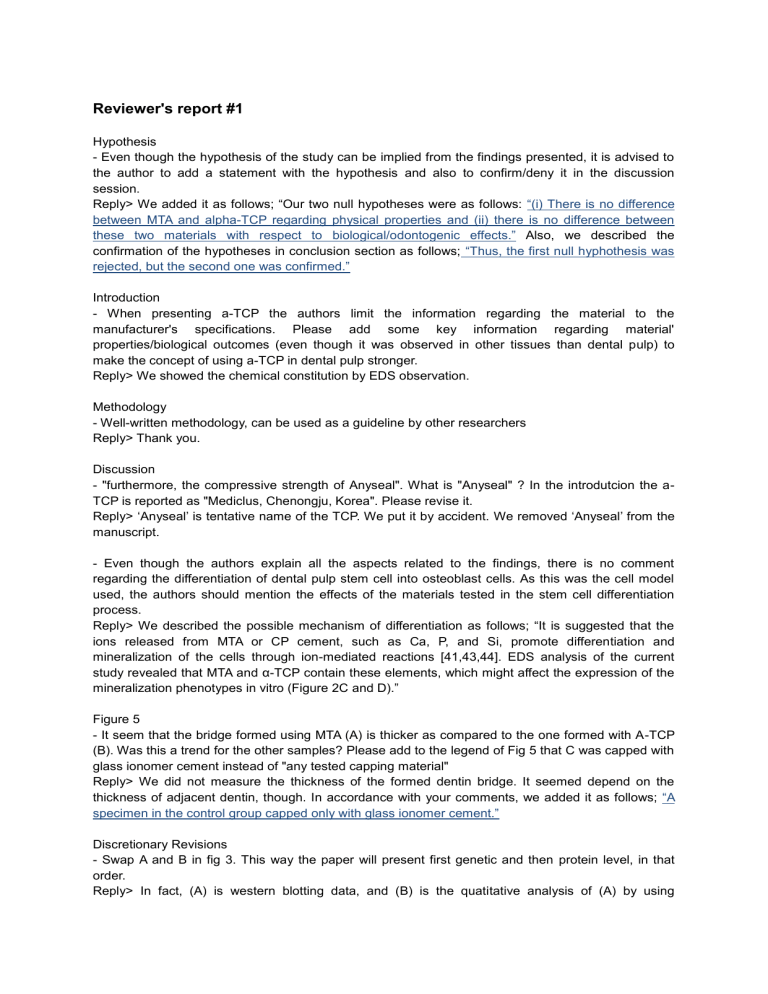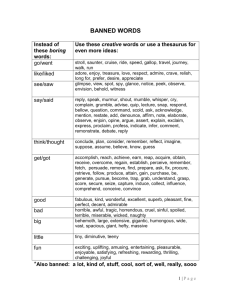Reviewer`s report #1 Hypothesis - Even though the hypothesis of the

Reviewer's report #1
Hypothesis
- Even though the hypothesis of the study can be implied from the findings presented, it is advised to the author to add a statement with the hypothesis and also to confirm/deny it in the discussion session.
Reply> We added it as follows; “Our two null hypotheses were as follows: “(i) There is no difference between MTA and alpha-TCP regarding physical properties and (ii) there is no difference between these two materials with respect to biological/odontogenic effects .” Also, we described the confirmation of the hypotheses in conclusion section as follows; “Thus, the first null hyphothesis was rejected, but the second one was confirmed.”
Introduction
- When presenting a-TCP the authors limit the information regarding the material to the manufacturer's specifications. Please add some key information regarding material' properties/biological outcomes (even though it was observed in other tissues than dental pulp) to make the concept of using a-TCP in dental pulp stronger.
Reply> We showed the chemical constitution by EDS observation.
Methodology
- Well-written methodology, can be used as a guideline by other researchers
Reply> Thank you.
Discussion
- "furthermore, the compressive strength of Anyseal". What is "Anyseal" ? In the introdutcion the a-
TCP is reported as "Mediclus, Chenongju, Korea". Please revise it.
Reply> ‘Anyseal’ is tentative name of the TCP. We put it by accident. We removed ‘Anyseal’ from the manuscript.
- Even though the authors explain all the aspects related to the findings, there is no comment regarding the differentiation of dental pulp stem cell into osteoblast cells. As this was the cell model used, the authors should mention the effects of the materials tested in the stem cell differentiation process.
Reply> We described the possible mechanism of differentiation as follows; “It is suggested that the ions released from MTA or CP cement, such as Ca, P, and Si, promote differentiation and mineralization of the cells through ion-mediated reactions [41,43,44]. EDS analysis of the current study revealed that MTA and α-TCP contain these elements, which might affect the expression of the mineralization phenotypes in vitro (Figure 2C and D).”
Figure 5
- It seem that the bridge formed using MTA (A) is thicker as compared to the one formed with A-TCP
(B). Was this a trend for the other samples? Please add to the legend of Fig 5 that C was capped with glass ionomer cement instead of "any tested capping material"
Reply> We did not measure the thickness of the formed dentin bridge. It seemed depend on the thickness of adjacent dentin, though. In accordance with your comments, we added it as follows; “A specimen in the control group capped only with glass ionomer cement.”
Discretionary Revisions
- Swap A and B in fig 3. This way the paper will present first genetic and then protein level, in that order.
Reply> In fact, (A) is western blotting data, and (B) is the quatitative analysis of (A) by using
densitometry. Thank you anyway.
Reviewer's report #2
Major Compulsory Revisions
This present manuscript aimed to evaluate the physical and biological properties of a-TCP and MTA.
Abstract:
Methods: Most of sentences are written in the passive voice: “The setting time, pH values, compressive strength, and solubility of the two materials were measured”. Can be edited to: We measured the setting time, pH values, compressive strength, and solubi lity of the two materials.”
Sentences written in a direct and active voice are generally more powerful and shorter than sentences written in the passive voice.
Reply> We tried to correct the sentences using active voice.
Statistical methods need to be included in this abstract section.
Reply> We included the statistical methods in accordance with your comments as follows; “The data were analyzed by an independent ttest for physical properties, one-way ANOVA for biological effects, and the Mann-Whitney U test for tertiary dentin formation. A P value of less than 0.05 was considered statistically significant for all tests.”
Results: The authors must include exact p values.
Reply> We could not include exact p values in abstract section because we performed many experiments. Instead, we included considered p value in this section as follows. “ A P value of less than 0.05 was considered statistically significant for all tests.
” Also, you can notice all the exact p values in results section and figures in detail.
Conclusions: Considering both materials (aTCP and MTA), last line “pulp capping material comparable to MTA”. It is not possible to get this conclusion considering only in vitro and animal test.
Reply> As you recommended, we removed the sentence.
Introduction:
Line 16: Include reference in the end of the paragraph.
Reply> We included references.
Are there any clinical studies about alpha-tricalcium phosphate cement in the endodontic treatment? If there are, please include them in the introduction.
Reply> Within the limitation of our knowledge, there is no clinical study regarding alpha-tricalcium phosphate cement in endodontic treatment yet.
Methods:
Again, the authors could be use active voice.
Reply> We tried to correct the sentences with active voice. We underlined the sentence corrected.
How was the sample size? What is the number of sample in each group? Please insert this information for each physical test.
Reply> We provided the sample size for each physical test in accordance with your comments.
Cell Morphology (SEM): What was the SEM magnification?
Reply> We inserted the magnification (x1000) in the legend for figure 2.
Statistical Analysis: The authors could include a specific part in the end of Methods. In this part is possible to give all explanations about statistical analysis. Statistical details are necessary.
Reply> In accordance with your valuable comments, we provided a specific part for statistical analysis at the end of the Materials and Methods section as follows; “The data for physical properties were analyzed by an independent samples ttest to compare the two materials. Statistical analysis was performed by one-way ANOVA followed by a multiplecomparison Tukey’s test for the cell viability test, western blotting, and Alizarin red staining. The Mann-Whitney U test was used to evaluate tertiary dentin formation. A P value of less than 0.05 was considered statistically signifi cant for all tests.”
Results: Include exact p value.
Reply> We included the p values in each figure.
Western blotting: Please include more details about the analysis methods. Is densitometry a valid method? Clarify.
Reply> In most studies, bands conducted by western blotting are usually quantified by using densitometric measurement. As a reference, we show you an example excerpted from the study performed by Fernandes et al. [Hypoxia-Inducible Factor1α and its Role in the Proliferation of
Retinoblastoma Cells. Pathol Oncol Res 2013]
Figure 1: include the exact p value directly in the graph for each difference (A, B, C, and D). Legend is very short. Please include some explanation about principal results.
Reply> We included the exact p value directly. Also, we expanded the legend as follows; “The pH values (A), solubility (B), and compressive strength (C) of MTA and TCP. Note that the setting time, pH values, and compressive strength of α-TCP was lower than that of MTA whereas the solubility of α-
TCP was higher than that of MTA. (D) Effects of MTA and TCP on cell viability measured by MTT assay. The cell viability of α-TCP-treated samples was higher than those of MTA at day 14.
*Significant difference between each group; P < 0.05.”
Cell morphologic analysis: Include more description about qualitative analysis using SEM.
Reply> We performed the cell morphologic experiment just to show the biocompatibility of the tested material in addition to the MTT assay. In most previous studies, in fact, SEM observation was used without any quantitative analysis. Please consider this. We provide some related articles as references.
[1] Asgary et al. Gene Expression and Cytokine Release during Odontogenic Differentiation of Human
Dental Pulp Stem Cells Induced by 2 Endodontic Biomaterials. J Endod 2014;40:387-392.
[2] GUVEN et al. Human tooth germ stem cell response to calciumsilicate based endodontic cements.
J Appl Oral Sci 2013;21:351-357.
[3] Lee et al. Effect of calcium phosphate cements on growth and odontoblastic differentiation in human dental pulp cells. J Endod 2010;36:1537-1542.
[4] Kang et al. Biocompatibility of mineral trioxide aggregate mixed with hydration accelerators. J
Endod 2013;39:497-500.
[5] Thomson et al. Cementoblasts maintain expression of osteocalcin in the presence of mineral trioxide aggregate. J Endod 2003;29:407-412.
[6] Min et al. Human pulp cells response to Portland cement in vitro. J Endod 2007;33:163-166.
Fig ure 2: In the same way, insert more information in the figure’s legend.
Reply> We inserted more information about the figure as follows; “Both groups showed flattened cells in close proximity to one another, and these were seen to be spreading across the s ubstrate.”
Figure 3: Gene-expression? Western blotting is for protein not DNA. Western blotting: I need more
description about this. No details about Figure 3B and Figure 3C.
Reply> We changed ‘gene’ into ‘protein’ in accordance with your comment. Also, we included the explanation of Figure 3B and C as follows; “(B) The graph shows the quantification of protein expression by densitometry and is presented as fold increases compared with control cells. (C)
Effects of MTA and TCP on the formation of calcifica tion nodules in hDPCs.”
Immunofluorescence analysis: More details about qualitative analysis.
Reply> Similar to cell morphological observation, we did not quantitative analysis regarding immunofluorescence analysis. We already showed the expression of odontogenic-related proteins
(DSPP, DMP1, and ON) by western blotting and calcific nodule formation quantitatively. Then, we just wanted to show the future readers the general pattern of protein expression by imaging. In most studies, therefore, immunofluorescence analysis is not conducted by quantitative analysis. For your reference, we provide some related articles.
[1] Liu et al. The expression of MCP-1 and CCR2 in induced rats periapical lesions. Arch Oral Biol
2014;59:492-499.
[2] Kim et al. Transcriptional Factor ATF6 is Involved in Odontoblastic Differentiation. J Dent Res
2014;93:483-489.
[3] Ozeki et al. Mouse-induced pluripotent stem cells differentiate into odontoblast-like cells with induction of altered adhesive and migratory phenotype of integrin. PLoS One 2013;11:e80026.
[4] Zhou et al. Adenosine monophosphate-activated protein kinase/mammalian target of rapamycindependent autophagy protects human dental pulp cells against hypoxia. J Endod 2013;39:768-773.
Figure 4: In the same way, insert more information in the figure’s legend.
Reply> We inserted additional information in the legend as follows; “Immunofluorescence analysis of hDPCs treated with medium only (A, D, and G), MTA (B, E, and H), or TCP (C, F, and I). Fluorescence images showing anti-DSPP (A-C), anti-DMP1 (D-F), and anti-ON (G-I) signals (green) of cells after 3 days of culture ( ×400). Note that the protein signals in the cells of the experimental groups were stronger than those in the cells of the control group.
”
Table 2: Include the statistical data in the table.
Reply> We added the sentence which represent the statistical analysis as follows; “ ¶ There was no significant difference between MTA and TCP with respect to the formation of tertiary dentin with either of the pulp capping materials ( P > 0.05).
Discussion: In this section the authors should explain the results in the first paragraph. After that, how do these findings compare to the published literature?
Reply> In accordance with your comments, we described the discussion section again.
What are the clinical implications? Both the strengths and weaknesses of the observations should be discussed.
Reply> We described the clinical implication as follows in conclusion section; “The present study indicates that α-TCP has a similar odontogenicity to MTA both in vitro and in vivo, whereas it has a much quicker setting time. However, α-TCP showed inferior physical properties including solubility and compressive strength. Thus, the first null hyphothesis was rejected, but the second one was confirmed. Collectively, our results suggest that α-TCP is potentially suitable for use as an effective pulp capping material. However, longterm clinical evaluation is required with respect to the use of α-
TCP.”
Statistical data do not be showed in this part of manuscript.
Reply> We inserted statistical significance in this section.
Why EDX data not showed in the manuscript?
Reply> We do have EDX data, but we thought total of six composite figures are too many to be included in one manuscript. However, in accordance with your comments, we included the EDX data.






